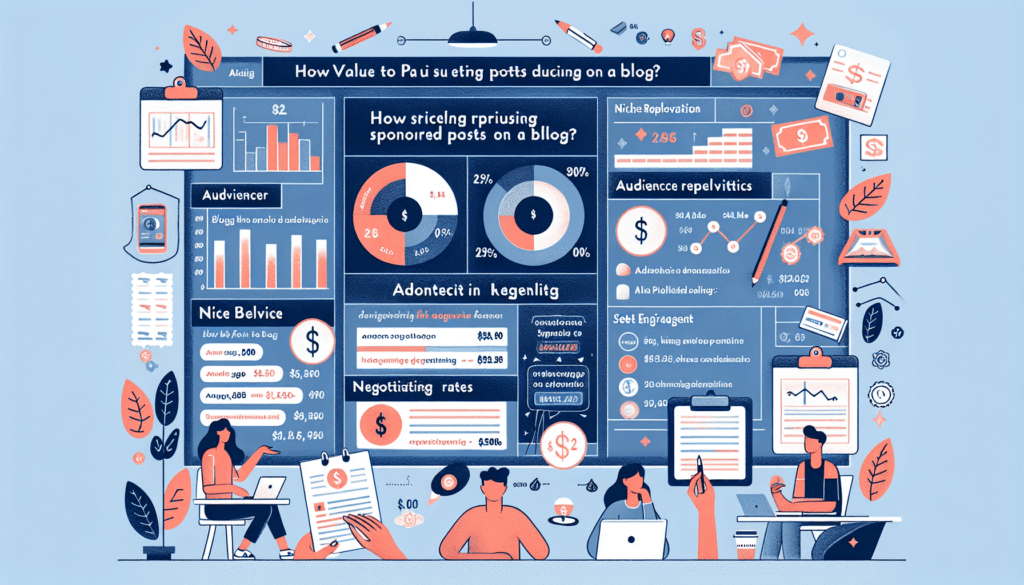Are you a blogger wondering about the best practices for pricing sponsored posts and advertising on your blog? Look no further! This article will provide you with valuable insights on how to effectively determine the right pricing strategy for your sponsored posts and advertising opportunities. Whether you’re a seasoned blogger or just starting out, understanding the best practices for pricing can make a significant difference in your blogging journey. So, let’s dive right in and discover the secrets to maximizing your blog’s potential and earning opportunities!
Understanding Sponsored Posts
Defining Sponsored Posts
Sponsored posts are a form of advertising in which companies or brands pay bloggers or content creators to publish content promoting their products or services. These posts are typically written in a way that integrates the brand’s messaging seamlessly into the blogger’s usual content style. Sponsored posts can provide a valuable source of income for bloggers and help companies reach a targeted audience.
Benefits of Sponsored Posts
Sponsored posts offer several benefits for both bloggers and sponsors. For bloggers, they provide an opportunity to monetize their content and generate income. By partnering with brands, bloggers can also enhance their credibility and expand their network. Additionally, sponsored posts allow bloggers to create authentic content that resonates with their audience, as they have the creative freedom to incorporate the brand’s message in a way that aligns with their readers’ interests.
For sponsors, sponsored posts offer a chance to reach a specific target audience. Bloggers often have a loyal and engaged following, which can result in increased brand visibility and potential customer conversions. Additionally, sponsored posts allow sponsors to tap into the bloggers’ expertise and authority, lending credibility to their products or services.
Types of Sponsored Posts
There are various types of sponsored posts that bloggers can offer to potential sponsors. These include product reviews, giveaways, sponsored tutorials or how-to guides, sponsored travel experiences, and sponsored social media campaigns. Each type serves a different purpose and provides unique opportunities for engagement with the blogger’s audience. By diversifying the types of sponsored posts they offer, bloggers can cater to a wider range of sponsor preferences and maximize revenue potential.
Determining Advertising Rates
Factors to Consider
When determining advertising rates for sponsored posts, bloggers should consider several factors. These include the size and engagement of their audience, the niche or industry they cater to, their blog’s reach and influence, and their previous experience with sponsored posts. Additionally, bloggers should evaluate the demand for sponsored posts in their niche and the rates charged by other bloggers with similar reach and influence.
Setting a Base Rate
To establish a base rate for sponsored posts, bloggers can consider their monthly blog traffic, social media followers, and other key performance metrics. Bloggers should also take into account their content quality, engagement metrics (such as comments and shares), and the perceived value they provide to sponsors. By setting a base rate, bloggers can ensure they are compensated fairly for their time and effort.
Calculating Value for Sponsored Posts
To calculate the value of a sponsored post, bloggers can consider factors such as the amount of time required to create the content, the promotion and distribution efforts involved, and the potential reach and engagement it can generate. Bloggers can also factor in the exclusivity or exclusiveness of their partnership with the sponsor, as well as any additional services they provide, such as photography or video creation.
Adjusting Rates for Different Ad Sizes
Bloggers may choose to offer different ad sizes for sponsored posts, such as banner ads or sidebar ads. For each ad size, bloggers can adjust their rates based on the visibility and prominence of the placement. Larger or more prominent ad sizes may command higher rates due to increased visibility and potential for audience engagement. Bloggers should also consider the duration of the sponsorship and whether multiple posts or content assets are included in the package.

Creating Pricing Packages
Tiered Pricing Options
To simplify the pricing process and offer flexibility to sponsors, bloggers can create tiered pricing options for their sponsored posts. This means creating different packages at varying price points, each offering different levels of exposure and deliverables. Tiered pricing allows sponsors to choose a package that aligns with their budget and marketing goals, while also providing bloggers with the opportunity to earn more based on the value they provide.
Incorporating Additional Benefits
In addition to the core sponsored post, bloggers can enhance their pricing packages by incorporating additional benefits for sponsors. These can include social media promotion, featuring the sponsored post on the blog’s homepage, inclusion in a newsletter to the blog’s subscribers, or even collaboration on a larger content marketing campaign. By offering these extra perks, bloggers can provide added value to sponsors and differentiate their packages from competitors.
Offering Custom Packages
While tiered pricing options are helpful, it’s essential for bloggers to remain flexible and offer custom packages tailored to specific sponsor needs. Some sponsors may have unique requirements or objectives, and by providing flexible options, bloggers can accommodate these requests and potentially secure long-term partnerships. Custom packages can include elements like sponsored product placements, brand ambassadorships, or exclusive content creation.
Negotiating with Sponsors
Setting Negotiation Goals
When entering into negotiations with sponsors, it’s important for bloggers to have clear goals in mind. These goals can include securing fair compensation, ensuring alignment with the brand’s values and target audience, and maintaining the integrity and authenticity of their content. Bloggers should also consider negotiating for additional benefits or deliverables that would enhance the sponsored post’s impact and value.
Maintaining Transparency
During negotiations, transparency is key. Bloggers should openly communicate their rates, terms, and expectations with sponsors, ensuring there are no surprises or misunderstandings. Being transparent about their audience demographics, engagement metrics, and any previous successful sponsored campaigns can also build trust and demonstrate the blogger’s credibility. Additionally, bloggers should disclose any potential conflicts of interest or affiliations that may affect their objectivity.
Negotiating Payment Terms
Payment terms are an important aspect of sponsored post negotiations. Bloggers should clearly outline their preferred payment schedule and methods, taking into account factors such as upfront payments, partial payments, or performance-based compensation. It’s also crucial for bloggers to establish a timeline for deliverables and ensure sponsors understand the value they will receive in return for their investment. By negotiating favorable payment terms, bloggers can mitigate financial risks and maintain a sustainable business model.

Ensuring Disclosure and FTC Compliance
Understanding Disclosure Requirements
When publishing sponsored posts, bloggers must comply with the Federal Trade Commission’s (FTC) guidelines on advertising disclosure. The FTC requires bloggers to clearly disclose to their audience that a post is sponsored or contains paid content. This disclosure should be made in a way that is easy for readers to understand and should be placed prominently within the post to ensure transparency.
Placing Clear Disclaimer Language
To ensure compliance with FTC guidelines, bloggers should include clear disclaimer language at the beginning or end of the sponsored post. This language should explicitly state that the post is sponsored and clearly identify the sponsoring brand. Bloggers can use phrases such as “This post is sponsored by [brand]” or “This content is in partnership with [brand]” to communicate the sponsorship relationship. Avoiding ambiguous or misleading language is crucial to maintaining trust with readers and adhering to legal requirements.
Educating Sponsors on Guidelines
Bloggers have a responsibility to educate sponsors about FTC regulations and the importance of compliance. Before entering into a sponsorship agreement, bloggers should clearly communicate the disclosure requirements and ensure sponsors understand their obligations. Providing sponsors with sample disclosure language and guiding them through the process can help minimize potential issues and protect both the blogger and the sponsor from legal consequences.
Measuring ROI and Performance
Tracking Post Engagement
To measure the success and return on investment (ROI) of sponsored posts, bloggers can track various engagement metrics. These metrics may include the number of views, comments, likes, shares, and time spent on the post. Bloggers can use web analytics tools and social media insights to gather data and assess the level of engagement the sponsored post generates. Comparing these metrics to the average engagement on non-sponsored posts can provide insight into the effectiveness of the sponsorship.
Monitoring Click-Through Rates
Click-through rates (CTRs) are another important metric to monitor when assessing the performance of sponsored posts. Bloggers can use tracking tools to analyze the number of clicks or conversions generated by the sponsored content, such as visits to the sponsor’s website or purchases made through affiliate links. By tracking CTRs, bloggers can evaluate the post’s ability to drive traffic and conversions, providing tangible data to demonstrate the value of the sponsorship to sponsors.
Collaborating with Sponsors for Feedback
To gain a comprehensive understanding of the effectiveness of sponsored posts, bloggers can collaborate with sponsors to gather feedback. Sponsors can provide insights on their objectives, key performance indicators, and the impact they observed from the sponsored content. This collaboration allows bloggers to continuously improve their approach, tailor their content to meet sponsor expectations, and strengthen the partnership for future collaborations.

Leveraging Social Media Promotion
Promoting Sponsored Posts on Social Media
Social media platforms offer a powerful tool for promoting sponsored posts and maximizing their reach. Bloggers can leverage their social media presence to showcase the sponsored content, utilizing engaging captions, eye-catching visuals, and appropriate hashtags to generate buzz. By strategically timing and promoting the sponsored post on different social media channels, bloggers can extend the post’s visibility and attract a wider audience.
Exploring Sponsored Influencer Collaborations
Collaborating with other influencers within the same or complementary niches can increase the exposure and impact of sponsored posts. Bloggers can partner with influencers who have a similar target audience or whose expertise aligns with the brand being promoted. This form of cross-promotion allows both parties to reach new audiences and benefit from increased credibility and trust. It’s important to ensure that the collaboration is authentic and mutually beneficial to maintain the trust of the audience.
Using Sponsored Hashtags
By creating and utilizing sponsored hashtags, bloggers can further amplify the reach and engagement of their sponsored posts. Sponsored hashtags provide a way for bloggers to categorize their content and enable audiences to easily find and engage with the sponsored posts. Bloggers should ensure the sponsored hashtag is unique and specific to the sponsored campaign to maximize its impact and create a sense of community around the promotion.
Building Relationships with Sponsors
Providing Exceptional Customer Service
Building strong relationships with sponsors is essential for long-term success in monetizing sponsored posts. Bloggers should prioritize exceptional customer service by being responsive, professional, and delivering on their promises. Maintaining open lines of communication with sponsors, addressing any concerns or issues promptly, and going above and beyond to meet sponsor expectations can contribute to building trust and fostering repeat partnerships.
Building Long-Term Partnerships
While one-off sponsored posts can be valuable, developing long-term partnerships with sponsors can provide more stable income and opportunities for growth. Bloggers should seek to cultivate relationships with sponsors who align with their values and target audience, and who appreciate the value they bring through their content and audience reach. By nurturing these relationships, bloggers can secure ongoing collaborations and establish themselves as trusted partners in the industry.
Creating Value-Added Opportunities
To strengthen relationships with sponsors, bloggers can go beyond the scope of sponsored posts and offer value-added opportunities. This can include hosting sponsored events or webinars featuring the sponsor’s products or services, curating custom content series for the sponsor’s website or blog, or providing exclusive discounts or promotions to the blogger’s audience. By offering these additional benefits, bloggers can demonstrate their commitment to creating value for sponsors and foster long-lasting partnerships.

Considering Additional Revenue Streams
Utilizing Affiliate Marketing
In addition to sponsored posts, bloggers can supplement their income by incorporating affiliate marketing into their monetization strategy. Affiliate marketing involves promoting products or services through unique affiliate links and earning a commission for each conversion or sale generated. By strategically integrating relevant affiliate links into their content, bloggers can provide additional value to their audience and earn passive income alongside sponsored posts.
Offering Premium Content or Memberships
To provide exclusive content and generate recurring revenue, bloggers can consider offering premium content or memberships. This can involve creating an online course, a subscription-based newsletter, access to a private community, or exclusive behind-the-scenes content. By offering unique and valuable content that caters to their audience’s needs, bloggers can diversify their income streams and establish a loyal subscriber base.
Exploring Sponsored Content Networks
Bloggers can also explore joining sponsored content networks as another avenue for securing sponsorship opportunities. These networks connect bloggers with brands actively seeking partnerships and streamline the negotiation and collaboration process. By leveraging the network’s resources and existing relationships, bloggers can broaden their reach and gain access to a wide range of sponsorship opportunities that may not be available to them individually.
Staying Updated on Industry Trends
Following Industry Blogs and News
To stay informed about the latest trends and best practices in sponsored posts and advertising, bloggers should actively follow industry blogs and relevant news sources. These sources often provide valuable insights, case studies, and tips from industry experts. By staying up to date, bloggers can adapt their strategies, anticipate shifts in the industry, and remain competitive in attracting sponsors and creating engaging content.
Attending Industry Conferences
Industry conferences provide valuable opportunities for networking and learning from industry leaders and peers. By attending conferences focused on blogging, content creation, or digital marketing, bloggers can gain insights into emerging trends and connect with potential sponsors. Conferences also provide a platform for sharing experiences, gaining inspiration, and discovering new strategies to enhance sponsored content and advertising on their blogs.
Networking with Fellow Bloggers
Networking with fellow bloggers is another effective way to gain insights and stay updated on industry trends. By engaging in online communities, joining blogging groups or forums, or participating in collaborative projects, bloggers can exchange ideas, discuss challenges, and learn from each other’s experiences. Building relationships with other bloggers in the same niche or industry not only fosters a sense of community but can also lead to collaborative opportunities and sponsor referrals.
By understanding the intricacies of sponsored posts, pricing, negotiation, disclosure requirements, and leveraging various strategies to measure performance and build relationships, bloggers can effectively monetize their blogs and create successful advertising campaigns. By combining these best practices with ongoing learning and adaptation to industry trends, bloggers can continue to thrive in the ever-evolving world of sponsored posts and advertising on their blogs.


